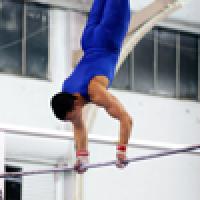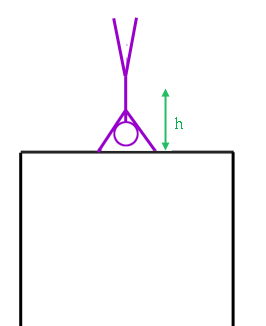
If you have ever ridden on a roller coaster you will know that you feel the greatest force at the lowest point of the ride. This is where the downward force of your weight is augmented by the downward centrifugal force you feel from your nearly circular motion around a roller coaster loop.

Something similar happens in a spectacular gymnastic routine on the high bar. When a gymnast performs a Giant Swing on the high bar, he has to rotate in a full circle while holding the bar with arms held fully extended (here is a nice video from Drills and Skills). Only the men do this particular exercise in competition; women use the uneven parallel (sometimes called asymmetric) bars to perform a different range of movements. The straightforward movement of the Giant Swing requires great strength and skill to perform. The high bar is a 2.4 cm steel bar raised 2.5 m above the ground and leather grips are used on the hands to maintain a tight grasp of the bar.
But how large are the forces that the swinging gymnast will experience when he performs a \emph{Giant}? Clearly, they are largest when his body is vertically below the bar. In this configuration the gymnast feels the downward force of his own weight plus the centrifugal force due to his circular motion. Suppose the gymnast has mass $M$ and moment of inertia $I$ and that the distance from the centre of gravity of his body to the bar is $h$. Then we can relate his energy of rotation when his body is vertically above the bar at the top of the swing to his energy of rotation when vertical at the bottom of the swing. Suppose that his angular velocity at the top is $w$ and at the bottom has increased to $W$. The increase occurs because his centre of mass falls from a height $h$ above the bar to a height $h$ below the bar and the consequent loss of potential energy, $2Mgh,$ increases the rotational energy, and hence his angular velocity, $W$. The energy conservation between the top and bottom of the swing is described by $$\mbox{Rotational energy at the bottom = Rotational energy at the top + Potential Energy lost}$$ $$\frac{1}{2}IW^2=\frac{1}{2}Iw^2+2Mgh.$$ At the bottom of the swing, the force on the gymnast is the sum of his weight $Mg$ and the centrifugal force created by the rotation of his centre of gravity in a circle of radius $h$ at an angular velocity of $W$, which is $MhW^2;$ so adding these together we have: $$\mbox{Maximum force felt by the gymnast} = Mg + MhW^2 = Mg + 4M^2gh^2/I.$$ If we write the moment of inertia of the gymnast as $I = Mk^2$ where $k$ is called the \emph{radius of gyration}, then the total force becomes $$\mbox{Total force felt by the gymnast }= Mg(1 + 4h^2/k^2 +hw^2/g).$$

In practice the last term on the right is much smaller than the second term – and if the gymnast started from a stationary handstand position, $w$ would actually be zero. We could try to build an accurate model of the mass distribution of a gymnast's body, which is roughly a cylindrical torso with two thinner tubular legs and arms attached. But rather than building such a model we'll resort to a rough estimate: the radius of gyration will be of order the size of $h,$ probably slightly bigger than $h$ because the body's mass is distributed farther from the centre in the vertical direction than the lateral one. With a typical angular velocity at the top of 2 to 3 metres per second and $g = 10 m/sec^2$ and a typical body size with $h = 1.3m,$ we have approximately $\mbox{Total force felt by the gymnast} \approx Mg(1 + 4 + 1.2) \approx 6Mg.$ Allowing for all our simplifications and particular choices for $k$ and $h$ (notice that making $h/k$ ten per cent smaller brings the total force nearer to $5Mg$) we should probably simply conclude that the total force will be somewhere between $5Mg$ and $6Mg$: that is, an acceleration between $5g$ and $6g$! This stress is very severe, although the head of the gymnast is spinning in a circle with a smaller radius than $h = 1.3m$ and so feels feels smaller forces on the blood vessels supplying the brain and on the retinas of the eyes. Notice that even if you start from a motionless vertical handstand you only reduce the total force by about one $g$. Interestingly, the force that a rider would feel at the bottom of a circular roller coaster ride is also about $6Mg$. To avoid such dangerous stresses roller coaster tracks are not circular. Our simple calculation reveals the extraordinary strength needed to perform even the most basic gymnastic exercise. Don’t try this at home!